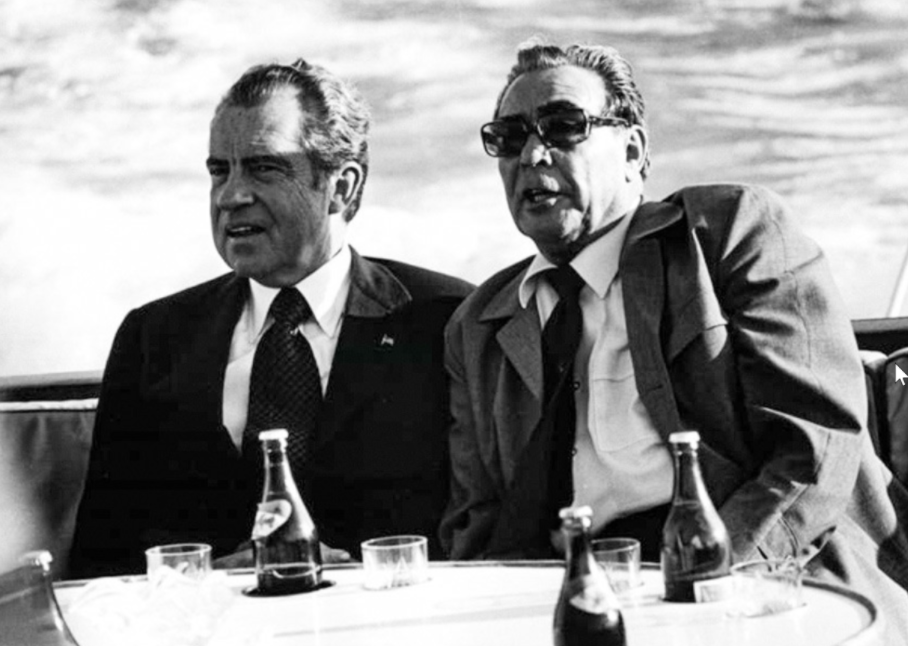If Only the Deck Chairs Could Talk
There is nothing quite like a cruise on a comfortable motoryacht to soften up the stiffest of stuffed shirts and bring the most self-important poohbahs down to earth. The motion of the boat, salt air, quite rumble of the engine, combined with an appropriate libation can engender a warm feeling of bonhomie in even the world’s most crusty potentates. Don’t miss the second part of our mini-history of presidential yachts.
Potomac
Franklin Delano Roosevelt often sailed on two presidential yachts, the Sequoia and the Potomac. On both ships, Roosevelt had an elevator installed to aid his movements between decks. On the Potomac, the elevator was concealed in a false smokestack. The elevator was operated by the President using a rope and pulley. An electric motor could easily have been installed, but Roosevelt used the elevator as a form of exercise. In 1939, he entertained King George VI and Queen Elizabeth of England.
In her book No Ordinary Time: Franklin and Eleanor Roosevelt, author Doris Kearns Goodwin writes “For the president (Roosevelt), the Potomac offered the perfect escape from both the heat of Washington and the persistent ring of the telephone. Having loved the water since he was a child, he enjoyed nothing more than sitting on the deck, an old hat shading his head from the sun, a fishing rod in his hands. The Potomac was not a luxury liner but a converted Coast Guard patrol boat, rough and ready, tending to roll with the waves, a sailor’s boat, with a fair top speed of sixteen knots.”
Roosevelt used the yacht to entertain politicians, host world leaders, play poker with friends, work on his stamp collection, and on one occasion, broadcast a “fireside chat” to the nation from a tiny radio room on board.
USS Williamsburg
By the time Harry Truman assumed office, the Potomac had been condemned by the Navy Department as being unfit for duty in open waters. As a result, the USS Williamsburg was commissioned the new presidential yacht. President Truman first cruised on the Williamsburg on November 10, 1945, and then used the ship to entertain a variety of foreign leaders including Prime Minister Winston Churchill. The Williamsburg was manned by the U.S. Navy involving 8 officers, 130 enlisted men, and 26 stewards.
Sequoia
Herbert Hoover loved spending time on the Sequoia. She was the longest-serving of the executive yachts. He was often seen playing medicine ball on its top deck. In 1932, the questionable decision to use a photo of the yacht as the centerpiece of his annual Christmas card drew mass criticism from a public who found such promotion to be indicative of Hoover’s inability to grasp the suffering caused by the Great Depression.
During subsequent presidencies, two of the most important decisions of the 20th century were made on the Sequoia. Franklin Roosevelt and General Dwight D. Eisenhower made plans for D-Day while aboard. Harry Truman is said to have pondered his decision to drop the atomic bomb on Japan while in seclusion on the Sequoia.
Faced with the decision to resign as a result of the Watergate scandal, President Richard Nixon boarded the Sequoia. Writing about those hours, Nixon’s daughter, Julie, recalls being invited to join “mother and him for dinner on the Sequoia. I do not think anyone in the family, with the exception of my father, ever thoroughly enjoyed the rather public rides on the Sequoia, but we recognized they were relaxing for him.
Being on the Sequoia was like bobbing along in a glass bottle. The boat moved at a snail’s pace, with no particular destination and under full view of escort Coast Guard speedboats. Now, in August of 1974, a flotilla of press accompanied us also. Reporters and photographers were posted as well at every bridge. We were the subject of a deathwatch.” Four days after the Sequoia trip, Nixon announced his resignation from the presidency.
The End to an Era of Presidents on Yachts
The Sequoia faithfully served several of the nation’s more recent presidents and their families. John F. Kennedy celebrated his last birthday on board the ship. Lyndon Johnson used it several times, although his height caused him problems due to the low ceilings. Johnson had the floor of the shower in the presidential stateroom lowered six inches so he could stand up in the shower. He also had a bar installed in place of Franklin Roosevelt’s wheelchair elevator.
Finally, when Jimmy Carter became president, he deemed the Sequoia a waste of taxpayer money. He said there was no need for the yacht. As a result, it was auctioned off for $286,000 in 1977.
All photos are from U.S. Library of Congress
Article by Victor M. Parachin courtesy of Southern Boating magazine



